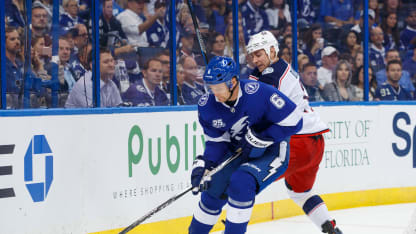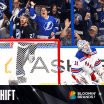There's plenty to like about the start the Tampa Bay Lightning have had to the 2017-18 season.
Through 18 games, the Lightning are 14-2-2 with 30 points, setting a new franchise record for best start to a season.
The Bolts are scoring 3.89 goals per game, tops in the NHL. They're allowing only 2.50 goals per game, third-best in the League. No other NHL team even ranks in the top 10 in both categories.
Tampa Bay leads the League for power-play goals (20). It's power play is ranked second in the League.
But another unit has quietly and methodically gotten better and better as the season's progressed and has become another weapon for an already loaded Lightning team.
Underrated Lightning penalty kill quietly one of NHL's best
The unit will be tested on Thursday against Dallas' League-best power play

© Scott Audette
Tampa Bay's penalty kill hasn't allowed an opponent power-play goal in six-straight games and has killed its last 15-consecutive opponent penalties. The penalty kill hasn't always been so effective, however. Through the first 12 games of the season, the PK gave up at least one power-play goal in seven contests and multiple power-play goals in three.
Anton Stralman, who leads the Lightning for average shorthanded time on ice at 3:04 per game, said the penalty kill has been focusing on the small details of late, particularly since going 0-for-2 in a 4-1 home loss to the Anaheim Ducks on October 28, and the attention to detail has paid off in big dividends.
"Everybody's doing all those small things whether it's the forwards pressuring up the ice and interrupting their breakouts or holding the blue line," Stralman said after the Bolts' practice Wednesday at AMALIE Arena. "Or when they come in our zone, we actually apply pressure early and clear a lot of pucks early on. We don't get hemmed in our zone and spend the whole time there. We're able to get to pucks and fire them down the ice. I think that's the difference."
The aggressive pressuring up the ice by the forwards has been the most notable change in the Lightning penalty kill of late. And so are the endless waves of personnel the Bolts can use interchangeably. They typically start with Brayden Point and Yanni Gourde harassing the opposing power play's puck handlers. Then when they tire, the Bolts can send Ondrej Palat and Tyler Johnson over the boards. When that duo has done its damage, Alex Killorn and Ryan Callahan are waiting to relieve.
The result is constant pressure and relentless energy which never allows the opponent to get comfortable on the power play, let alone set up inside the zone and start working the puck around.
"I've always killed that way, reading how they come up the ice and when it's the right time to pressure," Gourde said. "If the guys are looking towards the puck or if they look away, that's the right time to pressure. If you pressure then nobody knows where the puck is going to go and also you catch them on their heels a little bit. I think it's just a read of how to read people coming up the ice and obviously Pointer, Johnny, Pally, Killer have been amazing with that too. We usually get that read, and if we don't, we just back off and stay in our groove and try to defend from there. But when we get a chance to do it, it kills off a lot of seconds, so it's a good way to do that."
Gourde also plays on the Lightning's second power-play unit and knows firsthand how disruptive an aggressive penalty kill can be.
"I know how a pain in the ass it is to get a guy skating up ice and trying to score a goal while you're trying to break out," Gourde said. "Now, nobody's ready. You catch them on their heels. Everybody's like, 'Oh, there's two, and they're coming.' I like to take them by surprise and do that."
During the Lightning's recent California road trip, the penalty kill generated more shorthanded chances in games against San Jose and Los Angeles than the opposing team's power play was able to create. In the San Jose game with the Bolts up 2-1, Gourde took a delay of game penalty for playing the puck over the glass early in the second period. The Lightning penalty kill hounded the Sharks into numerous turnovers on the subsequent power play and drew their own penalty when Martin Jones was whistled for holding Ryan Callahan's stick near the end of the Sharks' power play. The momentum Tampa Bay generated continued well after the Lightning power play expired. A couple minutes later, Slater Koekkoek scored to make it 3-1 Lightning and Vladislav Namestnikov followed two-and-a-half minutes after with the Bolts' fourth marker.
"We've been killing a lot of penalties with the puck, especially the last three games," Stralman said. "The Sharks, they got booed on one of their power plays. That was kind of the turning point of that game I think when we really just did a really good job killing a penalty and we just took over after that."
Too, it doesn't hurt that the Lightning penalty kill has one of the top power plays in the NHL to go up against every day in practice. Steven Stamkos is tied for the NHL lead for power-play goals (6) and leads the League for power-play scoring. Nikita Kucherov is second in the League for PP scoring.
The Lightning penalty kill will get its stiffest challenge yet however on Thursday when the Bolts host the Dallas Stars at AMALIE Arena. Dallas owns the top power play in the League currently with a 30.2 percent conversion rate.
Tampa Bay is second at 28.6 percent.
"Our power play is amazing," Gourde said. "The way they move the puck is great. I think we kind of learn from them we don't want to be too overextended because we know how good players, they can seam passes across and that creates so much chaos in our PK. That's one thing we want to avoid is the chaos and try to avoid the seam pass. I think our power play is just great at that.
"I'm pretty sure if we can take that away from Stamkos and Kucherov, we can do it against anybody."


















